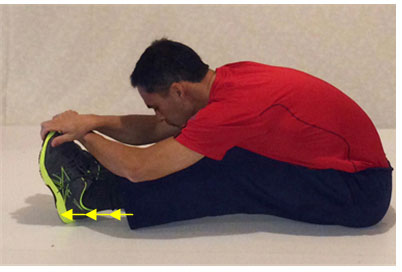Stop this bad habit & save yourself from chronic back pain

She can do it. But you’re not her.
Sherwin Nicholson | Updated July 15, 2025
See the picture above? NEVER DO THAT!
It looks healthy but it isn’t. It’s the worst exercise habit (and everyone does it).
Bad Habit #5: Touching your toes
Continued from: Bad Habit #4: Ignoring the pain
The pose above may appear very peaceful, natural and even motivational. But to me, I see someone who is very fit and active giving herself a disc bulge. You don’t want to risk any harm to your discs, do you?
Sure she can touch her toes but only at the cost of bending at her lower back while leaning forward. That’s bad. And at best her hamstrings are only being mildly stretched.
Why? Because if you observe the tilt of her pelvis, it’s not that far forward (anterior).
So her spine has to bend to allow her to touch her toes. Her hamstrings could lengthen a lot more than that.
If you can touch your toes, then you already can touch your toes!
What the heck does this mean?
It means that she can already touch her toes so she is not really exerting much effort to do it. She is just maintaining the length of her hamstrings. So when someone instructs you to do it (and usually they already can) you are being misled and can injure your discs.
This is like a swimmer telling a non swimmer to ‘just swim’. Non-swimmers need training of course to swim safely.
Leaning over to stretch your hamstring whether while you’re standing or seated is harmful to your discs.And you can either rupture them or wear them out prematurely.
By now you may have read my previous BAD HABIT posts and would have caught the flaw in the habit easily.
As you already know, it breaks 2 of the previous Rules of Thumb:
- Your legs should do all of the work
- Bend at the hips and knees every time
And it encourages the bad habit of leaning over before you stretch the hamstrings.
If the goal is to stretch the hamstrings to avoid leg cramps, muscle soreness or whatever, then you need to take advantage of the knee joint to do this for you. Stretch your hamstrings by extending your knees and NOT by leaning with your back.
One way you can tell whether or not a position such as touching your toes is safe to do is to tell yourself the following:
Is this something I can do while I am in pain? If not then don’t do it! When you suffer a spasm or sore disc, you can’t lean over. So don’t try it if you DON’T hurt. This is specifically when it comes to your discs.
Hamstrings can be lengthened at both ends. That is, from the hip joint OR the knee joint. Lengthening them at your knee joint is far safer.
Rule of Thumb: When you exercise or stretch, use your legs and NOT your back
What has began as a common stretch technique that is taught virtually everywhere to this day, has become a dangerous self-taught habit.
I literally do not know anyone who advises against this ‘leaning over to touch your toes’ habit. Perhaps from only the very people who are in pain now because of it.
If you don’t have back problems and are reasonably flexible, then you shouldn’t be too concerned. But if you are, then you’ll benefit quite a lot from following this rule of thumb. There is no harm is following it.
What can I do instead of leaning over?
I have written several articles on the safer alternatives to this bad habit. They are much safer and should really be a standard for keeping your discs safe and balanced.
If you would like to learn this better alternative, please check out the safer way to stretch your hamstrings.

It uses the Seated Hamstring Stretch Technique to protect your spine from harm. When your spine is stable, your discs are stable. You will have less disc pressure exterted on your spinal nerve roots and this will trigger fewer episodes of spasms for you.
Note: I did not lean over to reach my toes.
My arms are also bent, which means that I can reach beyond my toes if I wanted. Also, It is NOT necessary to lock your knees and force a straight leg.
You’ll achieve both a beneficial hamstring stretch and relief for your back with this stretch intensity.
By just following this one stretch, you’ll save yourself from multiple risks of injury and feel a lot better.
Continued from: Bad Habit #4: Ignoring the pain
More help for you:
How to stretch your hamstrings safely
